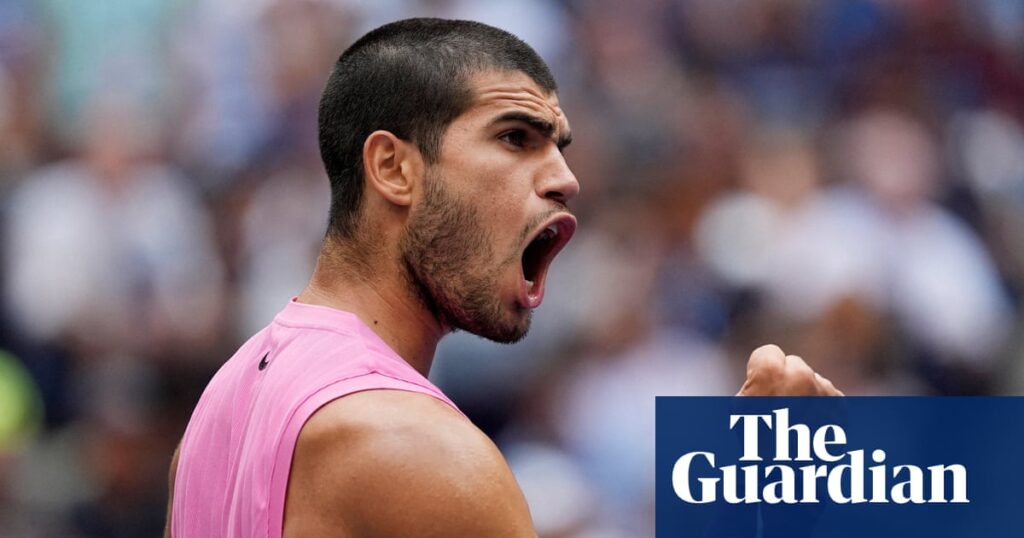By the final stages of a tense second-set tie-break, Novak Djokovic had left no stone unturned as he tried to cling on. He attempted to serve and volley, he threw in drop shots and vainly tried to take the first strike from his opponent. On more than one occasion, Djokovic’s miraculous defensive efforts drew 23,000 spectators to their feet.
Yet this time, in this late stretch of his glorious career, he simply did not have the level to match one of the new standard bearers of the sport he has dominated for so long. Across the net, Carlos Alcaraz continued his imperious form by maintaining his composure and holding his nerve to return to the US Open final with a 6-4, 7-6 (4), 6-2 victory.
There was once a time when Alcaraz himself would frequently speak of the “rollercoasters” he would find himself on in matches, his tendency to pair his spectacular shotmaking with bewildering performances and to leave himself in unnecessarily protracted battles. By reaching a grand slam final without dropping a set for the first time, this victory further underlines how Alcaraz has evolved into such a reliable and dependable player this summer.
He is in the form of his life, having now reached eight consecutive finals in addition to three consecutive major finals this year. At just 22, Alcaraz is the third youngest man in the open era to reach seven grand slam finals, behind only Björn Borg and Rafael Nadal. He now awaits Jannik Sinner or Félix Auger-Aliassime in the final.
“It feels amazing, to be honest, it means a lot to me,” said Alcaraz. “It wasn’t the best level of the tournament for me but I kept a good level from the beginning until the last point. I served pretty well, which today I feel was really, really important.”
For Djokovic, who had not competed since Wimbledon before this tournament, simply reaching a fourth grand slam semi-final in 2025 was an immense achievement. But with every physio appearance and physical struggle throughout this week, the strains of trying to compete at the highest level across the gruelling best-of-five-sets format at 38 years old has been as clear as ever.
Novak Djokovic fought hard but did not have the physical power to make his way past the much younger Carlos Alcaraz. Photograph: Kirsty Wigglesworth/AP
Despite being at such contrasting points in their careers, Djokovic and Alcaraz have spent the past few years battling as equals, with the Serb compiling a favourable head-to-head record and pulling off some of his most memorable wins against the Spaniard. This was their first meeting where the mileage in Djokovic’s legs was a clear impediment and despite how hard he fought and how deep he dug, the greatest player of all time just could not keep up.
Coming into the semi-final, Alcaraz had been the player of the tournament so far, efficiently rolling through his matches with total focus and determination to waste no unnecessary energy.
While Alcaraz was alert from the beginning, putting Djokovic under sustained pressure with the consistency and depth of his return of serve as he immediately broke, Djokovic was flat and erratic. Occasional moments of brilliance were counterbalanced by a consistent stream of sloppy mistakes. At 1-2 on Alcaraz’s serve, for example, Djokovic conjured up a stunning backhand down-the-line passing shot winner to drag the game back to deuce. He immediately followed that up with two missed second serve returns.
Although he held and maintained his lead, Alcaraz looked tense and contained himself when they entered into baseline rallies. But he hit his spots brilliantly with his serve, which guided him comfortably through the rest of his service games in the opening set.
skip past newsletter promotion
The best of our sports journalism from the past seven days and a heads-up on the weekend’s action
Privacy Notice:Newsletters may contain information about charities, online ads, and content funded by outside parties. If you do not have an account, we will create a guest account for you on theguardian.com to send you this newsletter. You can complete full registration at any time. For more information about how we use your data see our Privacy Policy. We use Google reCaptcha to protect our website and the Google Privacy Policy and Terms of Service apply.
after newsletter promotion
A potential turning point came at the beginning of the second set as Djokovic forced himself into the match with a slick opening return game. He broke Alcaraz’s serve with a supreme defensive point, throwing up a perfect lob before drawing a backhand error from the Spaniard. It would only delay the inevitable. With Alcaraz’s superior weight of shot and athleticism, the gulf between them was stark in the moments when Alcaraz found his top level.
Still, Djokovic fought as hard as ever. Despite the continuous pressure he endured in his service games, he found a way to pull himself through tight holds, somehow dragging himself into the tie-break.
On another occasion during the earlier part of his career, Alcaraz may have offered Djokovic a lifeline with an erratic performance in the tie-break, but not this time. After Alcaraz closed out the second set, Djokovic immediately requested the trainer, who massaged the Serb’s neck during the change of ends. The final set was merely a formality.
Over the years, the New York crowd has often been one of the most hostile audiences for Djokovic, and so one of the interesting developments in this latter part of his career has been the greater appreciation he has received from all audiences this year.
Throughout the match, as he desperately fought to stay in the opening set, chants of “Nole, Nole!” rang around Arthur Ashe Stadium. Every supreme defensive effort was saluted by the audience as if it was the last time they would see him. He departed making heart symbols with his hands to a long, heartfelt ovation from the packed arena.
Discover more from 6up.net
Subscribe to get the latest posts sent to your email.


